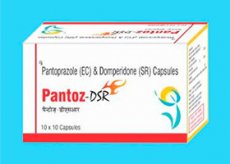Medical expert of the article
New publications
Preparations
Pantoz
Last reviewed: 03.07.2025

All iLive content is medically reviewed or fact checked to ensure as much factual accuracy as possible.
We have strict sourcing guidelines and only link to reputable media sites, academic research institutions and, whenever possible, medically peer reviewed studies. Note that the numbers in parentheses ([1], [2], etc.) are clickable links to these studies.
If you feel that any of our content is inaccurate, out-of-date, or otherwise questionable, please select it and press Ctrl + Enter.

Indications Pantose
The infusion solution is used in situations where the patient is unable to take the drug orally. It is used:
- for gastric or intestinal ulcers of a peptic nature;
- in case of bleeding in the gastrointestinal tract or a tendency to it;
- for GERD;
- to reduce the volume of gastric juice secreted in gastrinoma.
Pharmacodynamics
The element pantoprazole is an antisecretory substance that helps block secretion processes by slowing down H + /K + -ATPase (proton pump). The medicine inhibits the terminal stage of hydrochloric acid formation, while the origin of the irritant substance is not important. Pantos has a fairly long-term antisecretory effect (duration - about 24 hours).
Pharmacokinetics
After intravenous injection, the half-life of the active element is approximately 1 hour. The drug undergoes hepatic metabolism with the participation of the hemoprotein P450 system.
Excretion occurs primarily in urine. The drug is not excreted by hemodialysis.
 [ 16 ], [ 17 ], [ 18 ], [ 19 ], [ 20 ], [ 21 ], [ 22 ], [ 23 ], [ 24 ], [ 25 ]
[ 16 ], [ 17 ], [ 18 ], [ 19 ], [ 20 ], [ 21 ], [ 22 ], [ 23 ], [ 24 ], [ 25 ]
Dosing and administration
Before administration, the lyophilisate is dissolved using a 0.9% sodium chloride solution (10 ml is required). It is necessary to wait until the lyophilisate turns into a homogeneous liquid (it can be stored at a temperature of up to 25 ° C for a maximum of 2 hours), and then dilute it with a 5% glucose solution, ringer lactate solution or sodium chloride solution (0.9%) - in 100 ml.
Adults often need to administer 40 mg of solution once a day. The procedure must be carried out daily for 7-10 days.
In gastrinoma, therapy begins with the introduction of 80 mg of the drug at 12-hour intervals. Then the dosage can be gradually increased to 120 mg at 12-hour intervals; or the initial 80 mg can be continued at 8-hour intervals. The maximum permissible daily dose is 240 mg. Each infusion should last at least 15 minutes.
During the treatment of bleeding ulcers, it is necessary to administer 80 mg of the drug by the bolus method. The injection is performed 2-5 minutes after the hemostasis procedure. Then, drip intravenous administration of the solution begins immediately at a rate of 8 mg/hour. This procedure lasts 72 hours. Upon completion of these measures, the patient is transferred to taking pantoprazole in tablets.
Often the drug is administered intravenously by drip at a rate of 3 mg/minute, but with a duration of more than 15 minutes.
When administering infusions, use an infusion system equipped with a special filter that prevents precipitates (they can form inside the already prepared medicinal solution) from penetrating into the circulatory system. It is necessary to take into account that the infusion system must be filled with the solvent used for the initial dilution of the lyophilisate before connecting it.
Use Pantose during pregnancy
There is no information about the safety of using Pantoza in pregnant or nursing mothers. Because of this, it is allowed to use it during these periods only for vital indications, taking into account the ratio of benefits for the woman and the risk of negative consequences for the fetus.
During the period of therapy, it is necessary to stop breastfeeding.
Side effects Pantose
In general, the drug is well tolerated. But the use of the solution in large doses (IV injections) can cause pain in the sternum, abdominal pain and itching with a rash on the skin. More rarely, headaches, dyspeptic manifestations, vomiting, various disorders at the injection site, severe nausea, runny nose, diarrhea, and dizziness are noted.
Attention!
To simplify the perception of information, this instruction for use of the drug "Pantoz" translated and presented in a special form on the basis of the official instructions for medical use of the drug. Before use read the annotation that came directly to medicines.
Description provided for informational purposes and is not a guide to self-healing. The need for this drug, the purpose of the treatment regimen, methods and dose of the drug is determined solely by the attending physician. Self-medication is dangerous for your health.

